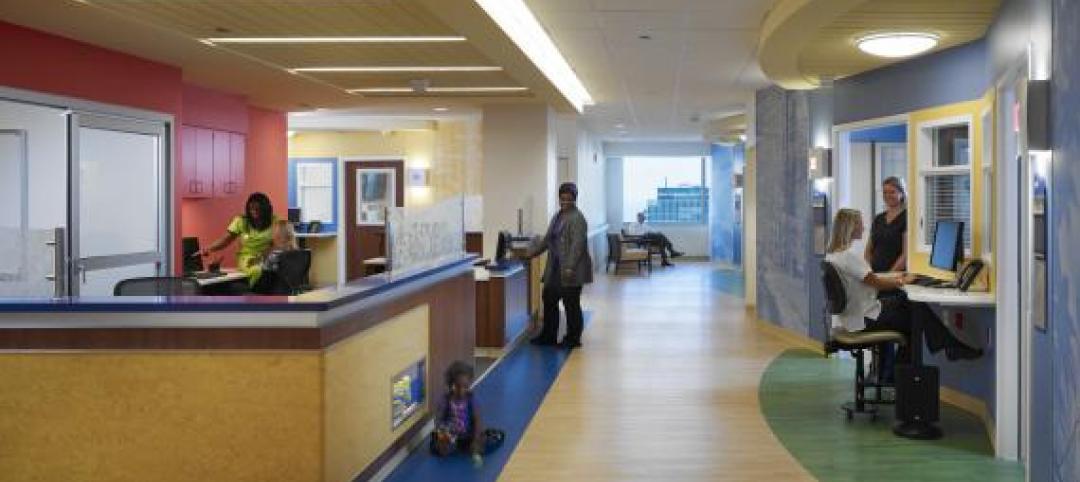The American Institute of Architects (AIA) has selected the recipients of the AIA National Healthcare Design Awards program, a showcase of the best healthcare building design and healthcare design-oriented research. Projects exhibit conceptual strengths that solve aesthetic, civic, urban, and social concerns as well as the requisite functional and sustainability concerns of a hospital.
Recipients were selected in four categories:
Category A: Built, Less than $25 million in construction cost
Category B: Built, More than $25 million in construction cost
Category C: Unbuilt, Must be commissioned for compensation by a client with the authority and intention to build
Category D: Innovations in Planning and Design Research, Built and Unbuilt
Jurors for the 2015 National Healthcare Design Awards include: Scott Habjan, AIA(Chair), SOM; Michael Folonis, FAIA, Michael W. Folonis Architects; Charles H. Griffin, AIA, WHR Architects, Inc.; Elizabeth Mahon, AIA, Ballinger; Marc Marchant, AIA, LS3P Associates LTD.; Connie McFarland, FAIA, McFarland Architects and Joseph Strauss, AIA, Cleveland Clinic (this juror was recused from the review of the Cleveland Clinic, Brunswick Family Health Center Emergency Department project).
Category A
Providence Sacred Heart Medical Center Pediatric Emergency Department; Spokane, WA
Mahlum

The building’s red panels are meant to be easily recognizable on the medical campus, while an atrium accented by wood welcomes visitors and calms patients. The Kid’s Club overlooks a healing garden, providing views for patients and their families. Advanced medical care is delivered via central care team zones close to patient care areas. More info here.
Cleveland Clinic, Brunswick Family Health Center Emergency Department
Westlake Reed Leskosky
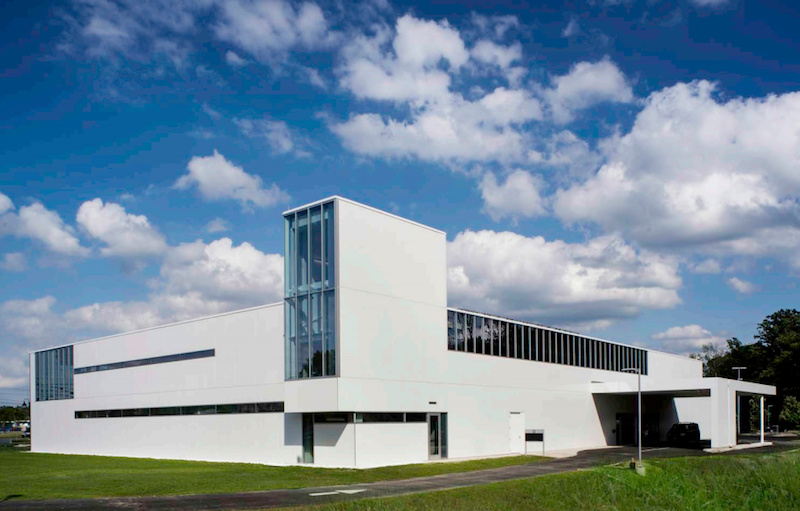
This addition to the Cleveland Clinic Brunswick Family Health Center provides a new 22,500 sf emergency department at grade, a processing lab, an imaging center, a second story expansion space of 17,000 sf intended for future fitout as exam rooms and offices and a roof top heliport. The addition is compatible with the original structure but easily identifiable as a new component. More info here.
New York Hospital Queens Astoria Primary Care Clinic; Queens, New York
Michielli + Wyetzner Architects
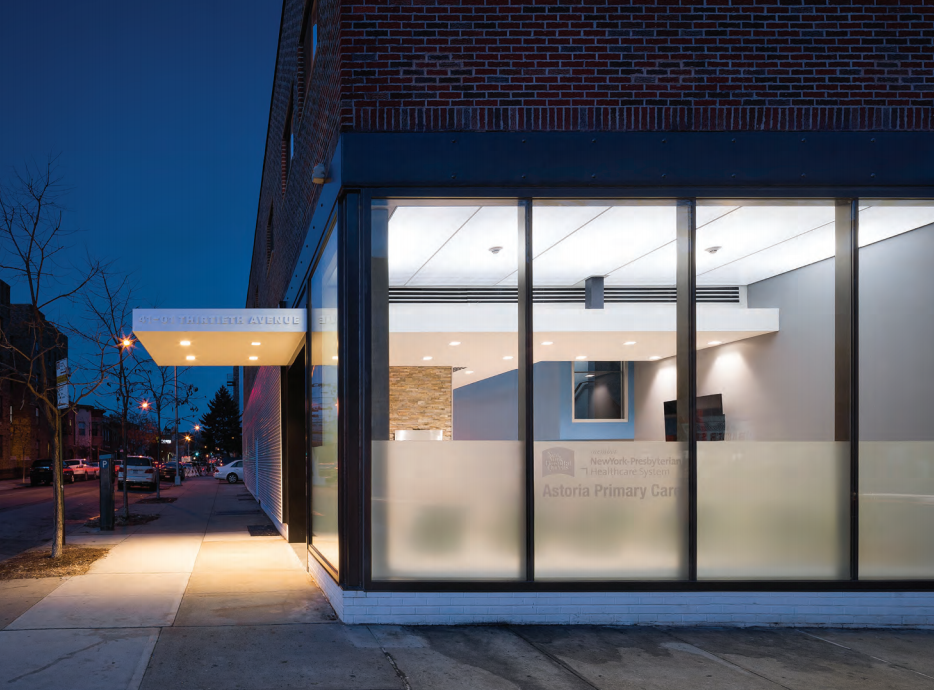
Located in Astoria on a corner site, the two-story brick building was gutted for new exam and consultation rooms. A perforated metal screen masks the irregular pattern of existing windows on the ground floor, allowing daylight to enter during the day and artificial light to glow at night. An illuminated ceiling is visible through the full height glass. The natural light and select use of color make is meant to soothe patients. More info here.
Vitenas Cosmetic Surgery and Mirror Mirror Beauty Boutique; Houston
Harrell Architects, LP

This ambulatory surgery center is squeezed into a redeveloped 19,100-sf site. The exterior is clad in white metal panels, corrugated zinc panels, and white plaster, alond with a two story corner window wall. The interiors have a sleek design with minimal color and crisp detailing. A variety of textures were introduced via the flooring, custom wall panels, and drapery. More info here.
Category B
Bridgepoint Active Healthcare; Toronto
Planning, Design and Compliance Architects: Stantec Architecture / KPMB Architects
Design, Build, Finance and Maintain Architects: HDR Architecture / Diamond Schmitt Architects
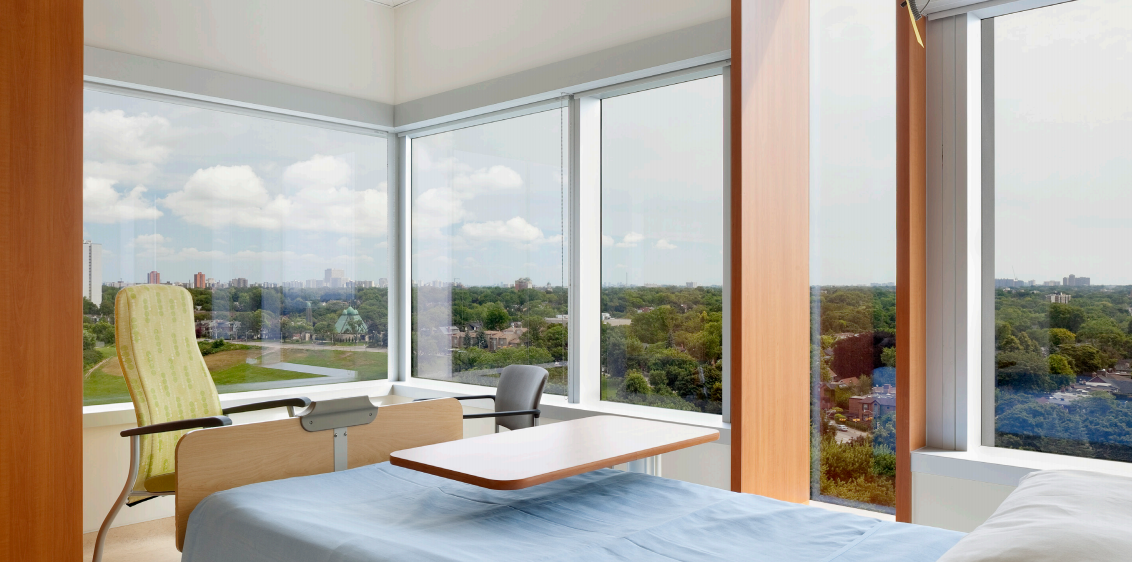
Bridgepoint Active Healthcare is designed for those coping with complex chronic disease. The nature-inspired space is designed to connect with a person’s sense of physical and emotional well-being. Panoramic views are in every patient room and open terraces are on the roof. The building facade has a randomized pattern of 472 vertical window projections, each representing a patient, for a personalized feel. More info here.
Category C
Fifth XiangYa Hospital; Changsha, China
Payette
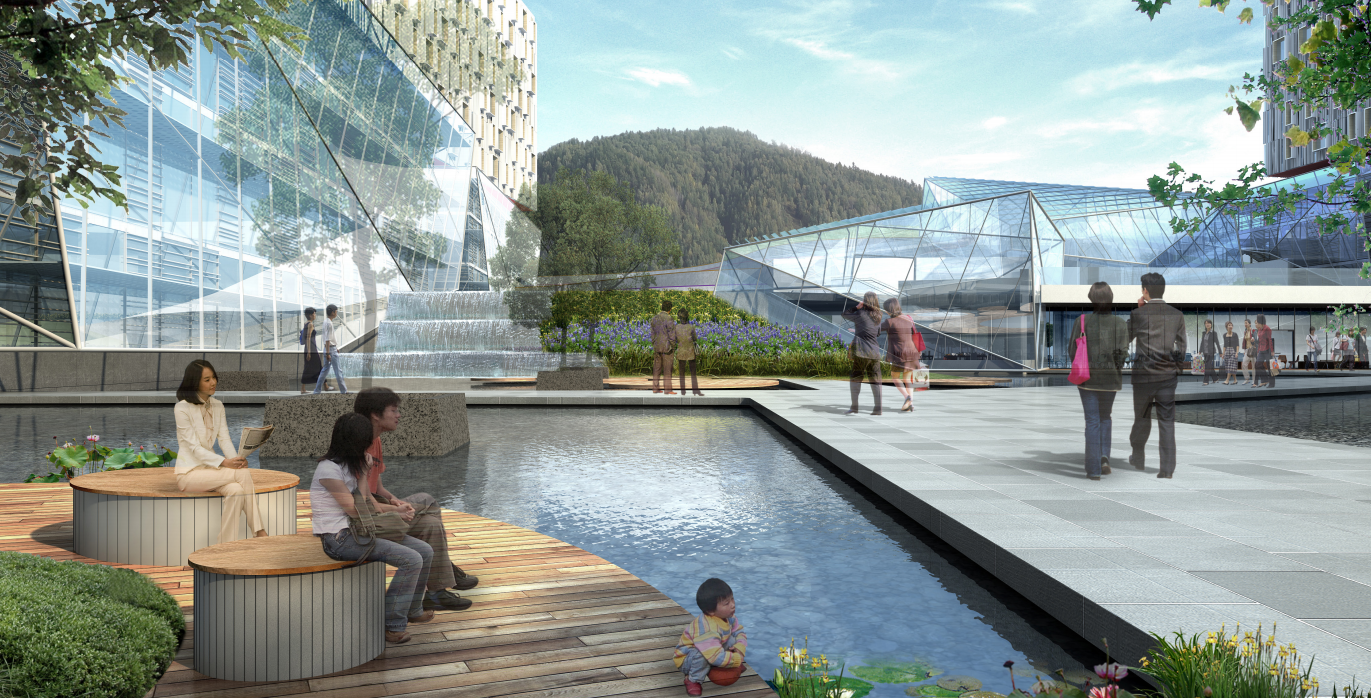
Located in ChangSha, China in the Tianxian district, the Fifth XiangYa Hospital is slated to anchor the developing community next to Xianguling Park. The hospital has 2,500 beds, and each half of the campus is organized around a central concourse, along which all the clinical functions are organized. The inpatient towers hover above it. Two levels of service functions and parking operate below ground. More info here.
U.S. Department of Veterans Affairs, Robley Rex VA Replacement Medical Center and VBO Office Building; Louisville, Kentucky
URS/SmithGroup Joint Venture
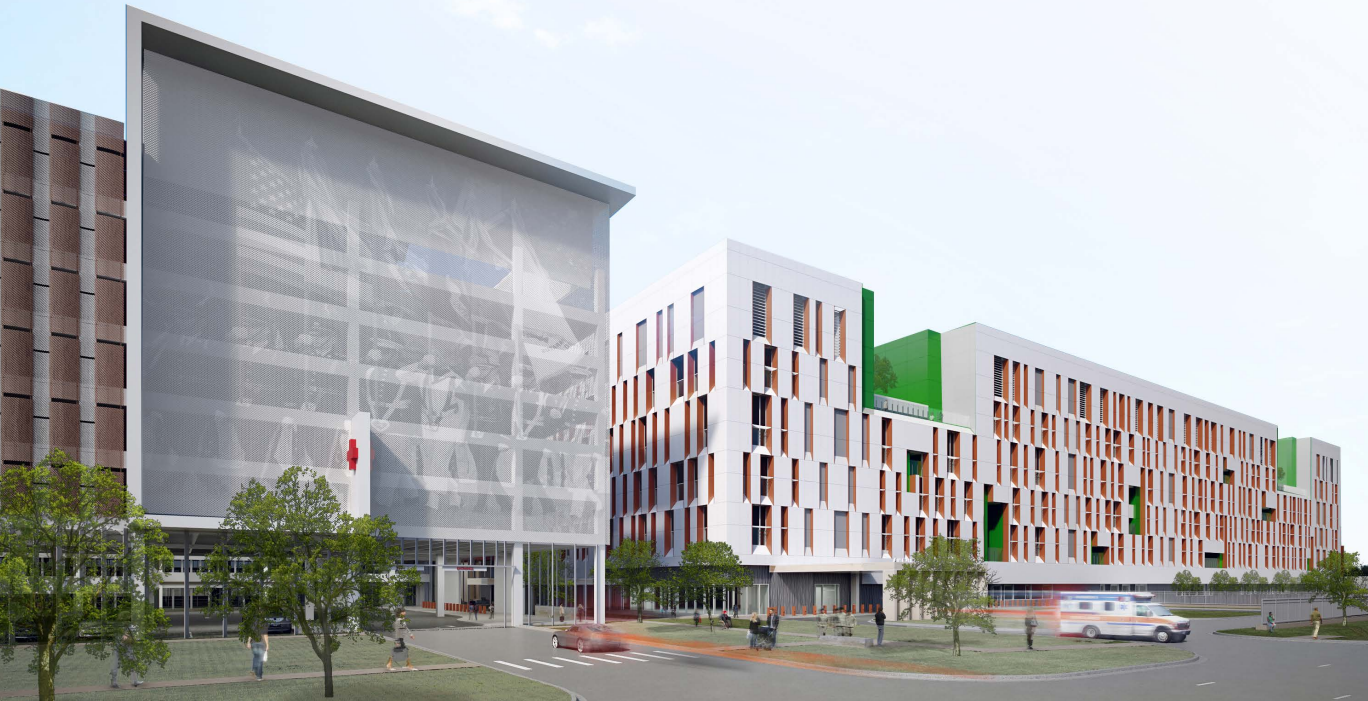
Patients and families at the Robley Rex VA Medical Center will find comfort in a light-filled concourse, quiet air gardens, and elevated courtyards. The settings' moods can range from contemplation to celebration. Designed as a full replacement of the existing facility, the facility is planned for one million sf of inpatient and outpatient services and 104 beds. More info here.
Category D
Studio Dental Mobile Unit
Montalba Architects, Inc.
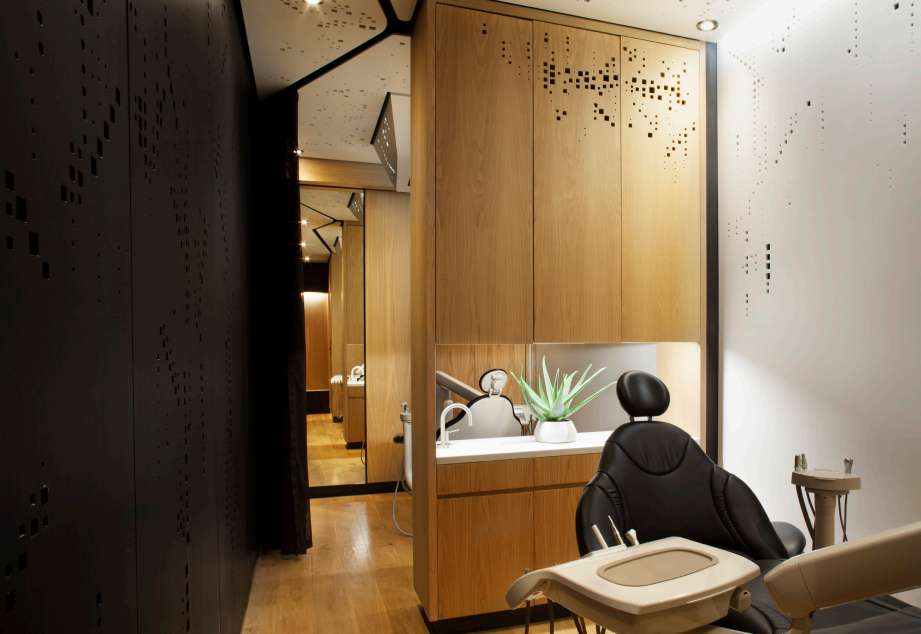
Montalba Architects Inc.’s wanted to create a spacious interior while accommodating Studio Dental’s Mobile Unit, which is a traveling dentistry program. The 26-foot-long trailer with 230 interior sf features a waiting area, sterilization room, and two operatories. The sterilization room is hidden behind millwork panels that wrap around to form the patient waiting bench. A centralized, double-sided millwork panel houses equipment for both operatories. More info here.
Related Stories
| Mar 19, 2014
How to develop a healthcare capital project using a 'true north charter'
Because healthcare projects take years to implement, developing a true north charter is essential for keeping the entire team on track and moving in the right direction.
| Mar 18, 2014
6 keys to better healthcare design
Healthcare facility planning and design experts cite six factors that Building Teams need to keep in mind on their next healthcare project.
| Mar 18, 2014
How your AEC firm can win more healthcare projects
Cutthroat competition and the vagaries of the Affordable Healthcare Act are making capital planning a more daunting task than ever. Our experts provide inside advice on how AEC firms can secure more work from hospital systems.
| Mar 13, 2014
Do you really 'always turn right'?
The first visitor center we designed was the Ernest F. Coe Visitor Center for the Everglades National Park in 1993. I remember it well for a variety of reasons, not the least of which was the ongoing dialogue we had with our retail consultant. He insisted that the gift shop be located on the right as one exited the visitor center because people “always turn right.”
| Mar 12, 2014
14 new ideas for doors and door hardware
From a high-tech classroom lockdown system to an impact-resistant wide-stile door line, BD+C editors present a collection of door and door hardware innovations.
| Feb 21, 2014
Naturally ventilated hospital planned in Singapore
The Ng Teng Fong General Hospital will take advantage of the region's prevailing breezes to cool the spaces.
| Feb 18, 2014
Study: 90% of healthcare providers say Affordable Care Act is 'step forward,' but major revisions needed
Providers are excited about opportunities to address long-term health issues in the U.S., but worries about the transition persist, according to a new study by Mortenson Construction.
| Feb 17, 2014
Lawmakers may take away control of Florida hospital project from the VA
The project is $100 million over budget and has missed its scheduled completion date.
| Feb 14, 2014
Crowdsourced Placemaking: How people will help shape architecture
The rise of mobile devices and social media, coupled with the use of advanced survey tools and interactive mapping apps, has created a powerful conduit through which Building Teams can capture real-time data on the public. For the first time, the masses can have a real say in how the built environment around them is formed—that is, if Building Teams are willing to listen.
| Feb 13, 2014
3 keys to designing freestanding emergency departments
Having physically disassociated from a central hospital, FEDs must overcome the particular challenges associated with a satellite location, namely a lack of awareness, appeal, and credibility. Gresham, Smith & Partners' Kristin Herman-Druc offers three keys to success.








